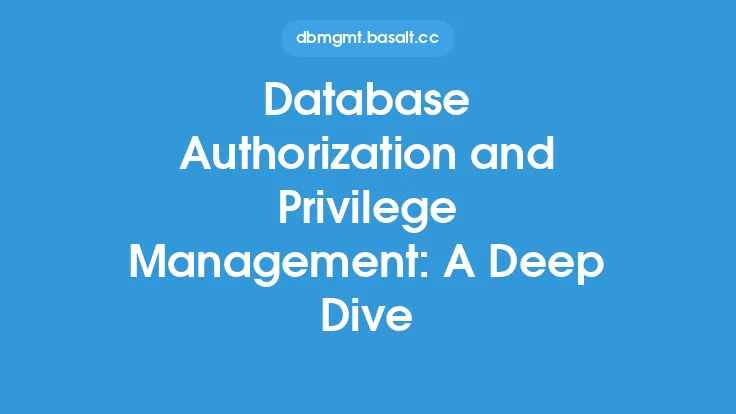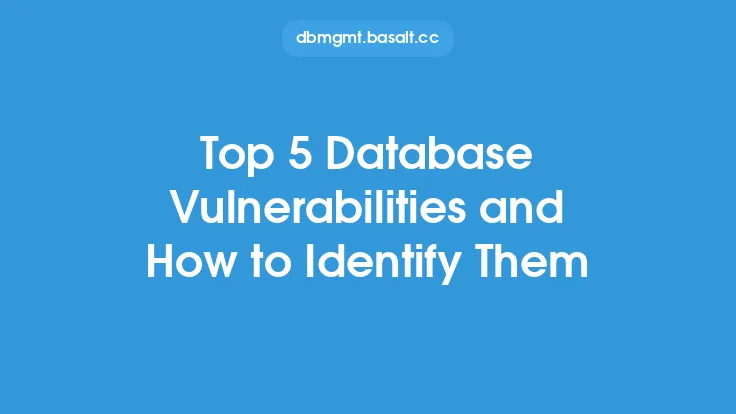Creating and managing database authorization policies is a critical aspect of database security. These policies define the rules and regulations that govern access to a database, ensuring that sensitive data is protected from unauthorized access, modification, or deletion. In this article, we will delve into the world of database authorization policies, exploring how to create and manage them effectively.
Introduction to Database Authorization Policies
Database authorization policies are a set of rules that determine what actions a user or a group of users can perform on a database. These policies are typically based on a user's role, responsibilities, and level of trust. The primary goal of database authorization policies is to ensure that data is accessed and modified only by authorized personnel, thereby preventing data breaches and maintaining data integrity.
Types of Database Authorization Policies
There are several types of database authorization policies, each serving a specific purpose. Some of the most common types include:
- Discretionary Access Control (DAC): This type of policy grants access to a database based on a user's identity and permissions. DAC policies are typically used in environments where access control is based on a user's role or position.
- Mandatory Access Control (MAC): This type of policy grants access to a database based on a user's clearance level and the sensitivity of the data. MAC policies are typically used in environments where access control is based on a user's security clearance.
- Role-Based Access Control (RBAC): This type of policy grants access to a database based on a user's role or responsibilities. RBAC policies are typically used in environments where access control is based on a user's job function.
Creating Database Authorization Policies
Creating database authorization policies involves several steps, including:
- Identifying Users and Roles: The first step in creating database authorization policies is to identify the users and roles that will be accessing the database. This includes determining the level of access each user or role requires.
- Defining Permissions: Once the users and roles have been identified, the next step is to define the permissions for each user or role. This includes determining what actions each user or role can perform on the database, such as read, write, or delete.
- Assigning Permissions: After defining the permissions, the next step is to assign them to each user or role. This can be done using a variety of methods, including granting permissions directly to a user or role, or using a role-based access control system.
- Testing and Refining: Finally, the database authorization policies should be tested and refined to ensure they are working as intended. This includes testing the permissions and access control to ensure that they are correct and that the policies are being enforced.
Managing Database Authorization Policies
Managing database authorization policies is an ongoing process that requires regular monitoring and maintenance. Some of the key tasks involved in managing database authorization policies include:
- Monitoring Access: One of the most important tasks in managing database authorization policies is monitoring access to the database. This includes tracking who is accessing the database, what actions they are performing, and when they are performing them.
- Updating Permissions: As users and roles change, the permissions assigned to them must also be updated. This includes adding or removing permissions as necessary to ensure that access to the database remains secure.
- Auditing: Regular auditing is essential to ensure that database authorization policies are being enforced correctly. This includes reviewing access logs and permissions to identify any potential security vulnerabilities.
- Training and Education: Finally, it is essential to provide training and education to users and administrators on database authorization policies and procedures. This includes educating users on their roles and responsibilities and ensuring that administrators understand how to manage and maintain the policies.
Best Practices for Database Authorization Policies
There are several best practices that can be followed to ensure that database authorization policies are effective and secure. Some of these best practices include:
- Least Privilege: The principle of least privilege states that users should only be granted the permissions necessary to perform their job functions. This helps to prevent unauthorized access to sensitive data.
- Separation of Duties: Separation of duties involves dividing tasks and responsibilities among multiple users or roles to prevent any one user or role from having too much power.
- Regular Review: Regular review of database authorization policies is essential to ensure that they remain effective and secure. This includes reviewing access logs and permissions to identify any potential security vulnerabilities.
- Automation: Automation can help to simplify the management of database authorization policies by automating tasks such as permission assignment and access monitoring.
Tools and Technologies for Database Authorization Policies
There are several tools and technologies available to help manage database authorization policies. Some of these tools and technologies include:
- Database Management Systems: Most database management systems, such as Oracle and Microsoft SQL Server, include built-in tools for managing database authorization policies.
- Identity and Access Management Systems: Identity and access management systems, such as Active Directory and LDAP, can be used to manage user identities and assign permissions.
- Access Control Systems: Access control systems, such as Kerberos and RADIUS, can be used to manage access to the database and enforce database authorization policies.
- Security Information and Event Management Systems: Security information and event management systems, such as Splunk and LogRhythm, can be used to monitor access to the database and detect potential security vulnerabilities.
Conclusion
In conclusion, creating and managing database authorization policies is a critical aspect of database security. By following best practices, using the right tools and technologies, and regularly monitoring and maintaining database authorization policies, organizations can help to ensure that their databases remain secure and that sensitive data is protected from unauthorized access. Whether you are using discretionary access control, mandatory access control, or role-based access control, the key is to ensure that database authorization policies are effective, secure, and aligned with the organization's overall security strategy.





